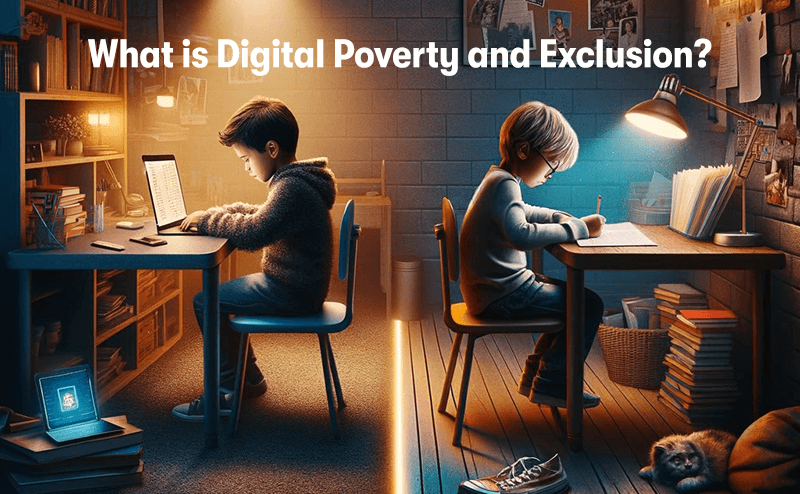What is Digital Poverty and Exclusion?
In the digital age, the promise of global connectivity and access to a wealth of information and services online is shadowed by a pressing challenge: digital poverty and exclusion. This phenomenon extends beyond the mere absence of internet connectivity or digital devices; it encapsulates a complex web of barriers that prevent individuals and communities from fully participating in the digital world.
From socioeconomic constraints to gaps in digital literacy, the implications of being digitally disenfranchised are profound, affecting educational opportunities, employment prospects, and access to essential services.
As we delve into the nuances of digital poverty and exclusion, it's crucial to understand the multifaceted nature of this issue and its broader impact on society, highlighting the urgent need for inclusive strategies to bridge the digital divide.
What is Digital Poverty?
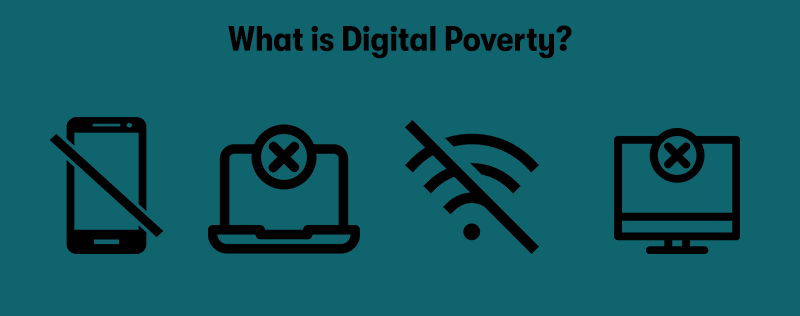
Digital poverty refers to the lack of access to digital technologies, including hardware (like computers and smartphones), software, and reliable internet connectivity. This concept also encompasses the skills and knowledge needed to use these technologies effectively. Digital poverty is a significant issue because access to digital technologies has become increasingly vital for participating in many aspects of modern life, such as education, work, healthcare, and social interactions. Key aspects of digital poverty include:
Lack of Access to Devices
This can mean not having a computer, smartphone, or tablet or sharing these devices with multiple family members, limiting individual access.
Insufficient Internet Connectivity
This includes not having any internet access or having unreliable or slow connections that hinder effective online participation.
Digital Literacy and Skills
Simply having access to technology isn't enough. People also need the skills to use these technologies effectively. This includes basic operational skills, as well as more complex abilities like evaluating online information and maintaining cybersecurity.
Affordability
The cost of devices and internet services can be prohibitive for many people, making it difficult for low-income households to afford the necessary technology.
Geographical Factors
People living in rural or remote areas often face greater challenges accessing high-speed Internet and other digital services than those in urban areas.
Digital poverty can lead to social and economic disadvantages, as it can hinder education, limit job opportunities, restrict access to essential services, and reduce the ability to engage in the digital economy. It's a global issue affecting both developed and developing countries and is a focus of policy and social initiatives aimed at bridging the digital divide.
What is Digital Exclusion?
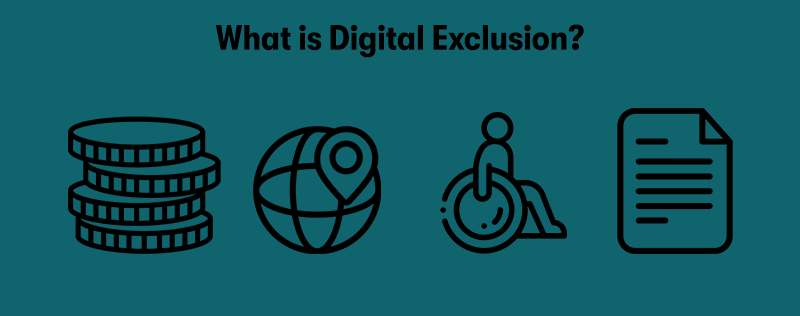
Digital exclusion refers to the phenomenon where individuals or communities are left behind in the digital revolution due to a lack of access or skills. This concept is closely related to digital poverty. Still, while digital poverty often emphasises the lack of access to digital tools and connectivity, digital exclusion can be broader, encompassing not only access and skills but also the ability to use digital technologies effectively in one's life. It highlights the gap between those who are able to benefit from the digital age and those who are not. Key aspects of digital exclusion include:
Lack of Access to Technology
This includes not having access to modern digital devices such as computers, smartphones, or tablets and lack of access to reliable and fast internet services.
Digital Literacy and Skills
Digital exclusion is not just about physical access to technology; it also involves the skills and knowledge required to use digital technologies effectively. This includes basic operational skills, understanding how to navigate online environments, and the ability to critically assess and use information found online.
Economic Barriers
The affordability of technology and internet services is a significant factor. The cost can be a barrier for low-income individuals and families, leading to digital exclusion.
Socio-Cultural Factors
Age, education, language barriers, and cultural attitudes towards technology can also contribute to digital exclusion. For example, older adults might feel less comfortable using digital technologies, or linguistic barriers may prevent non-native speakers from fully accessing digital content.
Geographical Challenges
People living in remote or rural areas often face greater challenges accessing high-speed Internet. This geographic digital divide exacerbates the exclusion.
Disability and Accessibility Issues
Individuals with disabilities may be excluded if digital technologies are not designed with accessibility in mind.
Digital exclusion has significant implications, as it can lead to educational disparities, reduced employment opportunities, limited access to essential services (like e-government or telehealth), and decreased civic participation. Tackling digital exclusion is crucial for ensuring equitable access to the opportunities provided by the digital age, and it's a key focus in policy discussions about technology, education, and social equity.
What is the Digital Divide?

The "digital divide" refers to the gap between individuals, households, businesses, and geographic areas at different socio-economic levels regarding their opportunities to access information and communication technologies (ICTs) and their use of the Internet for various activities. The digital divide encompasses both physical access to technology and the skills and knowledge to effectively use it. Key aspects of the digital divide include:
Access to Technologies
This includes the availability of internet-enabled devices like computers, smartphones, and tablets and the infrastructure needed for internet access. The divide is often between urban and rural areas, with rural areas having less access.
Quality of Connectivity
Having internet access is one thing, but the quality and speed of that access can vary greatly. Areas with slower, less reliable internet connections are at a disadvantage.
Digital Literacy and Skills
Access to technology is not enough if people do not have the necessary skills to use it effectively. This includes basic operational skills, an understanding of navigating online environments, and the ability to assess online information critically.
Socio-Economic Factors
Income levels, education, and employment status often correlate with access to technology and digital skills, leading to a socio-economic digital divide.
Cultural and Psychological Barriers
Attitudes towards technology, cultural norms, and personal preferences can also contribute to the digital divide. Some people might be less inclined to use digital technologies due to a lack of interest or fear of the unknown.
Age and Disability
Older adults and people with disabilities might face additional barriers in accessing and using digital technology.
The digital divide has significant implications, especially as more essential services and opportunities move online. It can affect education, healthcare, economic opportunities, and civic engagement. Efforts to close the digital divide often focus on increasing access to technology, improving internet connectivity, and enhancing digital literacy and skills among underserved populations.
Why Should You Care About Digital Poverty?
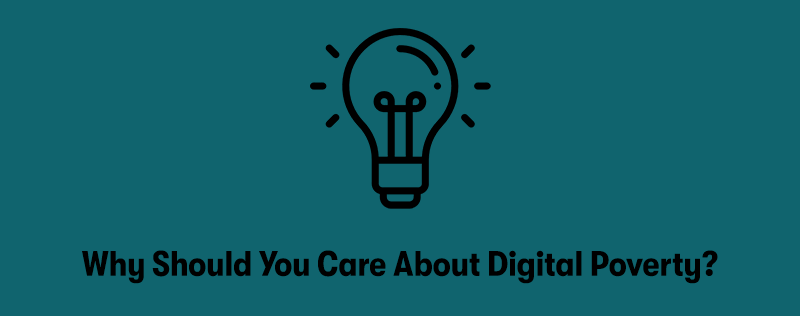
Businesses should care about digital poverty for several reasons, as addressing this issue can lead to both social benefits and business advantages:
Expanding Market Reach
By addressing digital poverty, businesses can expand their customer base. People who were previously unable to access online services due to a lack of technology or skills represent a potential market once these barriers are removed.
Corporate Social Responsibility (CSR)
Tackling digital poverty aligns with CSR initiatives, demonstrating a company's commitment to social issues. This can enhance brand reputation and customer loyalty, as consumers increasingly prefer companies with strong social responsibility values.
Innovation and Insight
Engaging with digitally excluded communities can offer fresh perspectives and insights, driving innovation. Businesses can develop new products and services tailored to the needs of these communities.
Workforce Development
Investing in digital skills training can help in creating a more skilled workforce. This is particularly important in sectors facing skill shortages.
Economic Growth
By contributing to reducing digital poverty, businesses can support overall economic growth. A digitally literate population can contribute more effectively to the economy.
Reducing Inequality
Businesses can play a role in reducing inequalities by ensuring that their services are accessible to all sections of society, including the digitally disadvantaged.
Building Partnerships
Addressing digital poverty often involves partnerships with governments, NGOs, and other businesses, which can lead to new collaborative opportunities and strengthen community ties.
Legal and Regulatory Compliance
Some regions have increasing legal and regulatory expectations for digital accessibility and inclusion. Proactively addressing digital poverty can help businesses stay ahead of these requirements.
Sustainability
Digital inclusion is part of a broader sustainability agenda. By addressing digital poverty, businesses contribute to sustainable development goals (SDGs), particularly those related to education, inequality, and economic growth.
Long-term Customer Relationships
By supporting digital inclusion, businesses can build long-term relationships with consumers who gain access to the digital world, creating loyalty and trust.
In summary, addressing digital poverty can help businesses tap into new markets, enhance their corporate image, drive innovation, and contribute to broader societal and economic development.
What Can be Done to Reduce Digital Poverty and Exclusion?
Businesses can play a significant role in reducing digital poverty and exclusion through various strategies and initiatives:
Improving Access to Technology
Businesses can donate or subsidise computers, smartphones, and other digital devices to individuals and communities in need. They can also partner with non-profits or government programs focusing on technology distribution.
Providing Affordable Internet Solutions
Telecommunication companies and ISPs can offer low-income households affordable, high-speed internet packages. They can also work on expanding internet access in underserved rural and remote areas.
Digital Literacy Training
Offering digital literacy programs to educate people on how to use technology effectively is crucial. These programs can focus on basic computer skills, internet safety, and how to access online services.
Supporting Educational Initiatives
Collaborating with schools and educational institutions to provide technology and training resources can help bridge the digital divide from an early age.
Inclusive Design and Accessibility
Ensure that online platforms, products, and services are accessible to all users, including those with disabilities. This involves adhering to web accessibility standards and considering diverse user needs in design processes.
Employee Volunteer Programs
Encourage employees to volunteer their time and skills to help individuals and communities overcome digital barriers. This can include teaching digital skills or helping non-profits with IT needs.
Public-Private Partnerships
Partner with governments, NGOs, and other businesses to develop and support initiatives aimed at reducing digital poverty. These partnerships can leverage the strengths and resources of different sectors for more effective solutions.
Research and Development
Invest in research to understand the causes and impacts of digital poverty and to develop innovative solutions to address them.
Promoting Entrepreneurship and Small Businesses
Provide resources, training, and support for small businesses and entrepreneurs to thrive in the digital economy. This can include access to online marketplaces, business management tools, and digital marketing training.
Advocacy and Awareness Campaigns
Use their platforms to raise awareness about digital poverty and advocate for policies and practices that support digital inclusion.
By implementing such initiatives, businesses not only contribute to the social good but also create a more inclusive, digitally literate customer base and workforce, which can have long-term benefits for their own sustainability and growth.
Is Digital Poverty Bad in the UK?
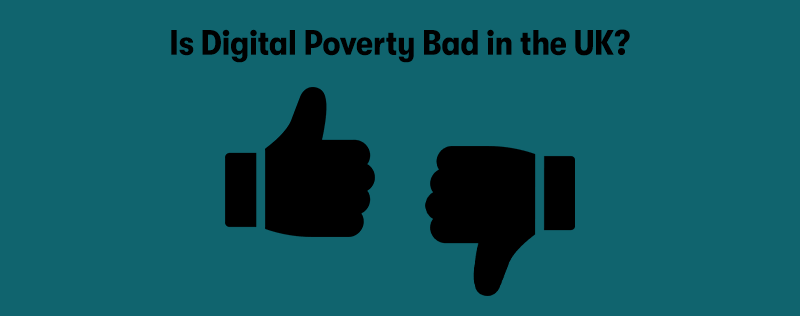
As of my last update in April 2023, digital poverty was a significant concern in the United Kingdom, although efforts were underway to address it. The extent and impact of digital poverty in the UK can be understood through several key points:
Access to Devices and Connectivity
While the UK is one of the world's leading digital economies, there are still disparities in access to digital devices and high-speed Internet. This issue is more pronounced in low-income households, certain rural areas, and among older populations.
Digital Skills Gap
There is a notable digital skills gap in the UK. A significant portion of the population lacks basic digital skills, affecting their ability to fully participate in the digital world, including online services, digital banking, and e-commerce.
Impact on Education
Digital poverty has a substantial impact on education. The COVID-19 pandemic highlighted this issue, as many students from low-income families struggled with remote learning due to a lack of suitable devices or reliable internet access.
Economic Implications
For individuals, lack of digital access and skills can lead to challenges in finding employment, as more jobs require digital literacy. For businesses, this gap can result in a smaller pool of digitally skilled workers.
Government and Non-profit Initiatives
The UK government and various non-profit organisations have been working to combat digital poverty. Initiatives have included providing devices to students, funding for internet access in disadvantaged areas, and programs to improve digital literacy across different demographics.
Corporate Involvement
Some businesses in the UK have also been involved in efforts to reduce digital poverty, either through corporate social responsibility programs or by partnering with government and non-profit organisations.
Regional Variations
The extent of digital poverty can vary significantly across different regions of the UK, with some areas facing more acute challenges due to economic, geographic, or demographic factors.
It's important to note that while significant efforts have been made, digital poverty remains a dynamic issue, influenced by technological advancements, economic changes, and policy decisions. Continuous efforts and innovative solutions are essential to ensure that all individuals in the UK can access and benefit from digital technologies.
What Causes Digital Exclusion and Poverty?
Digital exclusion and poverty are caused by a combination of interrelated factors that can vary across different regions and communities. Understanding these causes is essential to address and mitigate the issue effectively. Key factors include:
Economic Barriers
The most direct cause is often the cost of technology and internet access. Many low-income households cannot afford the expense of computers, smartphones, and broadband services.
Lack of Infrastructure
In many rural or remote areas, there is a lack of necessary infrastructure for high-speed Internet. This lack of connectivity is a significant barrier to digital inclusion.
Digital Literacy and Skills
Even when people have access to technology and the Internet, a lack of skills can be a barrier. This includes not only the ability to use devices and software but also understanding how to navigate the Internet safely and effectively.
Educational Disparities
Educational background plays a significant role in digital literacy. People with limited education may not have had the opportunity to develop digital skills.
Age-Related Factors
Older adults often have lower levels of digital literacy and may feel less comfortable using digital technology. They might also face physical challenges, such as impaired vision or reduced manual dexterity, limiting their ability to use digital devices.
Disability and Accessibility Issues
Individuals with disabilities may be excluded if digital technologies and online content are not designed with accessibility in mind.
Cultural and Language Barriers
Cultural attitudes towards technology and language barriers can also lead to digital exclusion. For instance, non-native speakers may struggle with predominantly English online content.
Social Isolation
People who are socially isolated for reasons such as geographic location or social circumstances may have fewer opportunities to engage with digital technologies.
Lack of Awareness or Interest
Some individuals may not be aware of the benefits of digital inclusion or may not have an interest in using digital technologies, often due to a lack of exposure or understanding of their potential uses.
Policy and Regulatory Frameworks
In some cases, government policies and regulations (or the lack thereof) can impact the extent of digital exclusion. This can include the level of investment in digital infrastructure, education policies, and regulations related to internet pricing and accessibility.
Addressing these causes requires a multifaceted approach that includes economic support, infrastructure development, education and training, policy changes, and the design of inclusive and accessible technology.
How Does Digital Poverty Affect Wider Poverty and Inequality?
Digital poverty significantly exacerbates wider poverty and inequality in several ways, reflecting the growing importance of digital access and literacy in modern society:
Educational Disparities
Digital poverty limits access to educational resources and opportunities. With increasing educational content and instruction delivered online, those without digital access or skills are at a significant disadvantage, potentially leading to lower educational outcomes and limited future opportunities.
Employment Opportunities
Many jobs now require digital skills, and job searching often occurs online. Those affected by digital poverty may struggle to find employment or be limited to lower-paying jobs that don't require digital skills. This perpetuates economic disparities and limits upward mobility.
Healthcare Access
Digital poverty can impede access to healthcare services, particularly telehealth and online health information. This can be particularly disadvantageous in areas with limited physical healthcare resources.
Social Exclusion
As social interactions and community engagement increasingly occur online, those without digital access or skills can become socially isolated, further exacerbating feelings of exclusion and inequality.
Access to Government Services
Many government services and benefits are moving online. Without digital access and literacy, individuals may struggle to access these services, leading to a lack of support and further entrenchment of poverty.
Financial Services and Digital Banking
The shift towards online banking and digital financial services can marginalise those without digital access, making it more difficult to manage finances, access credit, or receive financial education.
Economic Growth and Innovation
Digital poverty limits the participation of a segment of the population in the digital economy. This affects individual economic opportunities and can hinder broader economic growth and innovation.
Inequality Amplification
Digital poverty often disproportionately affects already disadvantaged groups, including low-income families, rural communities, elderly populations, and people with disabilities. This amplifies existing inequalities and creates a cycle where the lack of digital access and skills perpetuates other forms of poverty and marginalisation.
Global Disparities
On a global scale, digital poverty accentuates the divide between developed and developing countries, potentially impacting global economic balance and cooperation.
Future Readiness
As technology continues to advance, the gap between those who are digitally literate and those who are not is likely to widen, potentially leading to even greater disparities in the future.
Therefore, addressing digital poverty is crucial for the immediate benefits of increased digital inclusion, combating broader societal inequalities and ensuring equitable access to opportunities in a rapidly digitising world.
Where Can You Study Digital Sustainability?
At Purple Griffon, we offer an ITIL® 4 Specialist Sustainability in Digital & IT (SDIT) training course. This course will help you to:
- Understand how to use the ITIL guiding principles to deliver value by creating sustainable digitally enabled products and services.
- Effectively address VUCA challenges through sustainable strategies, procurement, products and practices.
- Obtain a practical grounding in the key principles of sustainability.
- Conduct a complete cost-benefit analysis identifying potential risks and opportunities using best practice guidance.
Final Notes on Digital Poverty and Exclusion
In conclusion, our exploration of digital poverty, digital exclusion, and the digital divide reveals significant challenges in our increasingly interconnected world. While technology advances rapidly, a substantial portion of the population in the UK and globally remains marginalised due to a lack of access, skills, and resources. This digital divide exacerbates existing socio-economic inequalities, affecting education, employment, healthcare, and social participation.
Businesses have a critical role in addressing these disparities, with benefits extending beyond corporate social responsibility to broader societal and economic impacts. As we move forward, it is imperative to focus on inclusive strategies and policies that ensure equitable digital access and literacy. Only then can we bridge the gap and create a more inclusive digital future for all.


